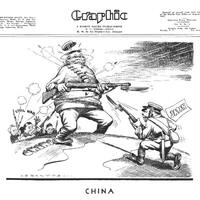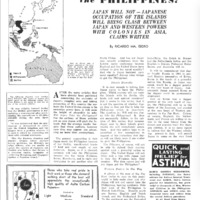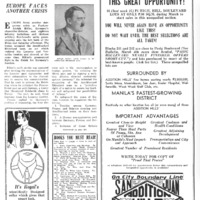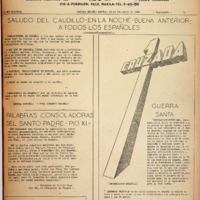The interwar period in Asia was marked by conflicts consequence of World War II and the legacy of Western colonialism in the region. China was left humiliated and in chaos, divided in a civil war between the nationalists led by Chiang Kai-Shek and the communists led by Mao Tse Dong (Woodruff 2002, 182-85). As Torsten Weber (2018, 320-22) argues, the rejection of Japan’s racial equality proposal at Versailles in 1919 and the shutting down of Japanese immigration to the US due to racial discrimination in 1924 fueled a self-Orientalizing Asianism in a background of nationalist and imperialist reality that would ultimately lead to Japan’s occupation of Manchuria in 1931, and pave the road its imperialistic expansion in Asia during World War II.
Filipino press paid close attention to the Sino-Japanese war (1937-1945), which preceded the conflict in Asia and the Philippines. The Chinese community in the archipelago, one of the largest Chinese populations abroad, saw the invasion with a lot of concern, especially when market integration with Japan was increasing, and a wave of patriotic mobilization raised on the archipelago (Tan 1981). As expansionist wars escalated in the continent, several articles were published fearing a similar destiny for other countries, such as Indochina. C. Kuangson Young, Chinese consul in the archipelago, even suggested that an attack on the Philippines was likely if China was to fall.
In this context, some authors, such as Ricardo Mª Isidro, argued that, “Just as Korea was a dagger pointed at the very heart of Japan, the Philippines will be in the hands of the Japanese, and pointing at Western possessions in the Far East”. He therefore hoped that foreign powers, and especially England, would oppose such invasion as they had opposed the Italian invasion of Abisinia. The Filipinos, Isidro continued, “will not be able to defend their country against such a powerful nation as Japan [and] The United States will not likely risk a war with Japan just to help the Filipinos keep their country”.
Besides the early approach of some intellectuals to Japanese Pan-Asianism (CuUnjieng 2017; Villaescusa Illán 2020), Filipinos, who identified themselves mainly with the west through American and Spanish influences, saw a possible Japanese occupation with fear. After the Sino-Japanese War, even former pro-Japanese journalists staunchly supported, not only independence, but also national defense efforts, as was the case with TVT Publishing Corporation’s publications such as The Tribune (Trota Jose 1990, 47).
At the same time, the Japanese community in the Philippines was also the largest since the early XXth century, and the American military bases in the archipelago were of big geopolitical importance (Matthiessen 2015). There was an increasing concern that this could work as a casus belli for Japan, which could turn Luzon into an Asian “Sudetenland”. The president of the Commonwealth, Manuel Quezon, while condemning these hypothetical aggressions and defending to the very end the right to self-determination and the reception of migrants and refugees, had to acknowledge that “so long as there are nations that believe, and back their faith with force, that their national interests are conveyed by them are paramount to the interest of any other nation and even to the interest of mankind, our only recourse is to build up our own force to defend ourselves against aggression”.
The Spanish civil war arguably distracted the European powers from the Asian theater (Woodruff 2002, 186), creating a perfect opportunity for the Japanese invasion of China. Paradoxically, although German and Italian expansionism in Europe and in Ethiopia, respectively, was seen with preoccupation, most parts of the Spanish-speaking community of the Philippines sided with the conservative side during the Spanish civil war, led by General Francisco Franco, who established a dictatorship in Spain (1939-1975) that was, from its very beginning, supported both by Nazi Germany and the Spanish speaking community within the Philippines (Rodao 2012b). El Debate, controlled by Andrés Soriano, supported the coup d’état from the very beginning, and Excelsior, the most influential magazine in Spanish, sided with the Francoist side, and launched a campaign against leftists politicians such as Spanish president Manuel Azaña (Rodao 2012a, 475-78).
Later on, several publications with tight links to Spanish Fascism were created, such as ¡Arriba España!, which would report on the conflict on a daily basis, presenting it as a holy war and a Christian revolution against the “red” forces of communism and liberalism. Based on this defense of Catholicism and Christian civilization, as opposed to communism, most of the Spanish-speaking publications, which were related in many cases to the Spanish regular orders and the University of Santo Tomás, radicalized their ideological positions.
An interesting publication was Yugo. Revista Falangista: Doctrina de unidad nacional-sindicalista, a publication tightly united to the Foreign Service of the Spanish fascist party Falange Española, that gave a view of the conflict not only critical with progressive forces, but also with conservatives and monarchists such as Andrés Soriano, owner of Cervezas San Miguel (Rodao 2012a, 483-85). Through Yugo, the increasingly fascistized Spanish community in the Philippines could wonder some of the most important tropes of Francoist discourse, such as the Siege of Toledo’s Alcazar or the Aragon front.
Bibliographic references
Box, Zira. 2005. "La invención de la tradición franquista: la enseñanza de la historia, la Guerra Civil y el último combate entre el Bien y el Mal". In Las escalas del pasado: IV Congreso de Historia Local de Aragón, edited by Carlos Forcadell Álvarez, and Alberto Sabio Alcutén, 379-392. Barbastro: Instituto de Estudios Altoaragoneses.
CuUnjieng, Nicole. 2017. "Cultures of Empire, Nation, and Universe in Pres. José P. Laurel’s Political Thought, 1927–1949". Philippine Studies: Historical and Ethnographic Viewpoints 65 (1): 3-30.
Hayase, Shinzo. 1999. "Japan and the Philippines". Philippine Studies 47 (1): 30-47.
Matthiessen, Sven. 2015. Japanese Pan-Asianism and the Philippines from the Late Nineteenth Century to the End of World War II: Going to the Philippines Is Like Coming Home? Leiden: Brill.
Rafael, Vicente L. 2000. White love and other events in Filipino history. Durham: Duke University Press.
Rodao, Florentino. 2012a. «El español durante la guerra civil: las revistas ideologizadas». Historia cultural de la lengua española en Filipinas: ayer y hoy. Madrid: Verbum, 459-509.
———. 2012b. Franquistas sin Franco: una historia alternativa de la Guerra Civil Española desde Filipinas. Granada: Editorial Comares.
Tan, Antonio S. 1981. "The Philippine Chinese Response to the Sino-Japanese Conflict, 1931–1941". Journal of Southeast Asian Studies 12 (1): 207-23.
Trota Jose, Ricardo. 1990. "The 'Tribune' During the Japanese Occupation". Philippine Studies 38 (1): 45-64.
Villaescusa Illán, Irene. 2020. "Transcultural Orientalism: Re-Writing the Orient from Latin America and the Philippines". En Transcultural Nationalism in Hispano-Filipino Literature, editado por Irene Villaescusa Illán, 45-75. Historical and Cultural Interconnections between Latin America and Asia. Cham: Springer International Publishing.
Weber, Torsten. 2018. Embracing ’Asia’ in China and Japan: Asianism Discourse and the Contest for Hegemony, 1912–1933. London: Palgrave Macmillan.
Woodruff, William. 2002. "Asia in the Interwar Years". In A Concise History of the Modern World: 1500 to the Present A Guide to World Affairs, edited by William Woodruff, 183-202. London: Palgrave Macmillan.




